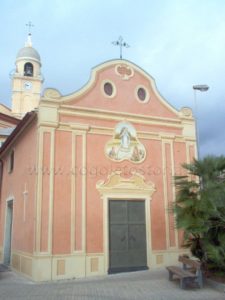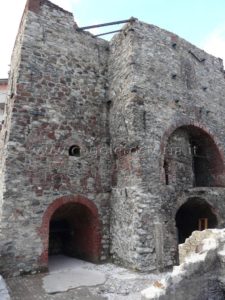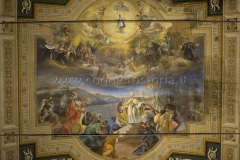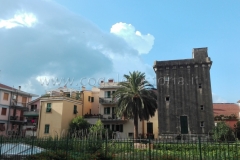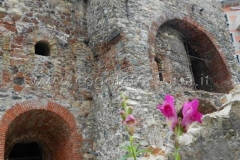Christopher Columbus’ native house
The house where Christopher Columbus was born is located in the street once said of the “Carroggio”, today named Rati street. 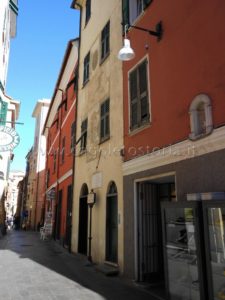 That house is mentioned in the will of Domenico Columbus (Christopher’s father) written in 1449. The interior of the house cannot be visited now as people live there.
That house is mentioned in the will of Domenico Columbus (Christopher’s father) written in 1449. The interior of the house cannot be visited now as people live there. 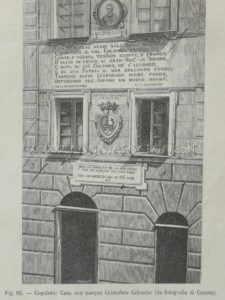 The original building was composed of a ground floor and two upper floors. In 1650 a descendant, Reverend Antonio Columbus, had the facade painted with the portrait of Christopher Columbus and some inscriptions. In nineteenth century that house was visited by Princes belonging to Savoy family and by many visitors coming from all over the world. Among them the English poet Alfred Tennyson, poetess Maria Konopnicka and the novelist Jozef Ignacy Kraszewski, both Polish. Furthermore many American captains came to Cogoleto with their ships in order to visit the house and admire the Admiral’s portrait kept in the Town Hall. A marble commemorative stone put on the part of the building in front of the sea celebrates the arrival in Cogoleto, in 1847, of the ship named “Princeton” belonging to American Navy. For more info visit the site (text only in Italian): www.cristoforocolombostoria.it/
The original building was composed of a ground floor and two upper floors. In 1650 a descendant, Reverend Antonio Columbus, had the facade painted with the portrait of Christopher Columbus and some inscriptions. In nineteenth century that house was visited by Princes belonging to Savoy family and by many visitors coming from all over the world. Among them the English poet Alfred Tennyson, poetess Maria Konopnicka and the novelist Jozef Ignacy Kraszewski, both Polish. Furthermore many American captains came to Cogoleto with their ships in order to visit the house and admire the Admiral’s portrait kept in the Town Hall. A marble commemorative stone put on the part of the building in front of the sea celebrates the arrival in Cogoleto, in 1847, of the ship named “Princeton” belonging to American Navy. For more info visit the site (text only in Italian): www.cristoforocolombostoria.it/
Parish church of Saint Mary
The first document mentioning the old parish church of Saint Mary in Cogoleto dates back to 1308. The old church had three naves and twelve altars. The church as we can see today dates back to the end of nineteenth century.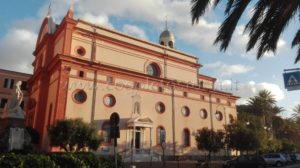 In that period in fact being the old church not large enough to contain Cogoleto’s inhabitants during holy services and being also unstable, it was decided to destroy the old structure and build up a larger and more beautiful church. This happened in 1877. During the progress of construction works a good location to Columbus family’s altar was quaranteed (we are referring to the altar devoted to Saint John the Baptist). All Cogoleto people helped for the better realisation of the works, the technical direction of which was assigned to Cav. Maurizio Doufour (author of the drawing) and to Cav. Angelo Borgo. On the facade of the church in front of the sea a marble commemorative stone was posed in 1888. That commemorative stone remembers the presence in that place of an old castle, destroyed by Napoleon I in order to allow the construction of the road connecting Nice to Rome.
In that period in fact being the old church not large enough to contain Cogoleto’s inhabitants during holy services and being also unstable, it was decided to destroy the old structure and build up a larger and more beautiful church. This happened in 1877. During the progress of construction works a good location to Columbus family’s altar was quaranteed (we are referring to the altar devoted to Saint John the Baptist). All Cogoleto people helped for the better realisation of the works, the technical direction of which was assigned to Cav. Maurizio Doufour (author of the drawing) and to Cav. Angelo Borgo. On the facade of the church in front of the sea a marble commemorative stone was posed in 1888. That commemorative stone remembers the presence in that place of an old castle, destroyed by Napoleon I in order to allow the construction of the road connecting Nice to Rome.
Saint Lawrence Oratory, since long ago the headquarter of the Confraternity having the same name, has very old origins. The first news at the moment found dates back to 1514 and is constituted by a fine register kept in the oratory. In that register are listed the names of died members of the Confraternity from the origins of the Confraternity up to 1855. From the register it seems that the Confraternity was founded in 1400. So it is assumed that the oratory was present since fifteenth century. Long time ago in the Oratory were held the meetings of the local “Parliament” in order to discuss and take important decision for the benefit of the people as for example wheat provision to cope with food needs of families during pestilences. Inside the Oratory are kept and displayed very precious works. Among them the painting above the main altar reproducing the martyrdom of Saint Lawrence, painted by G.B. Carlone (1603 – 1684).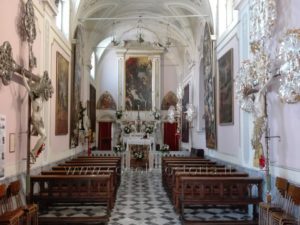 Moreover inside the Oratory are shown works of painter Gino Grimaldi (Isola della Scala – VR 1889 – 1941). Outside the Oratory, in front of the sea, a sculpture representing Saint Lawrence (he is the patron of Cogoleto and the patronal festivity is on 10 August) made by the artist Antonio Brilla from Savona.
Moreover inside the Oratory are shown works of painter Gino Grimaldi (Isola della Scala – VR 1889 – 1941). Outside the Oratory, in front of the sea, a sculpture representing Saint Lawrence (he is the patron of Cogoleto and the patronal festivity is on 10 August) made by the artist Antonio Brilla from Savona.
Defence medioeval towers
Among the buildings of particular interest the presence in the territory of Cogoleto of some towers must be noticed. These towers can still be seen even if they are now merged into the urban built up areas of Cogoleto and Lerca. The features of these buildings are quite close to similar constructions that the government of Genoa Republic used to defend the territories of the domain. In particular the tower behind Rati street, located close to the railway station, has been recognized by the relevant Department as a “defence medioeval tower”. 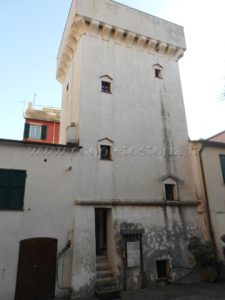 The mentioned towers anyway must be put in connection with raids carried out by barbarian pirates who were used to go robbing oversea and overland. The construction of a belt of watching and defence towers had the aim to protect coasts from ground incursions that had as consequence robbery and kidnapping of people to be sold in well organized slaves markets.
The mentioned towers anyway must be put in connection with raids carried out by barbarian pirates who were used to go robbing oversea and overland. The construction of a belt of watching and defence towers had the aim to protect coasts from ground incursions that had as consequence robbery and kidnapping of people to be sold in well organized slaves markets.
The lime furnace named “Bianchi” dates back to the middlle of nineteenth century. It is known as a furnace said of “layered” and “continuous fire” type, feeded with wood bundles and coal. It is an impressive structure, perfectly restored and made suitable to be visited together with its remaining adjacent spaces. It represents an important part of the history of productive activities existing in the past in Cogoleto. The structure’s management has been assigned by Cogoleto municipality to an association named “Associazione Fornace Bianchi” that guarantees its openings, providing guided visit of the interior as well as organizing cultural events. For more info visit the site (text only in Italian): www.associazionefornacebianchi.org

